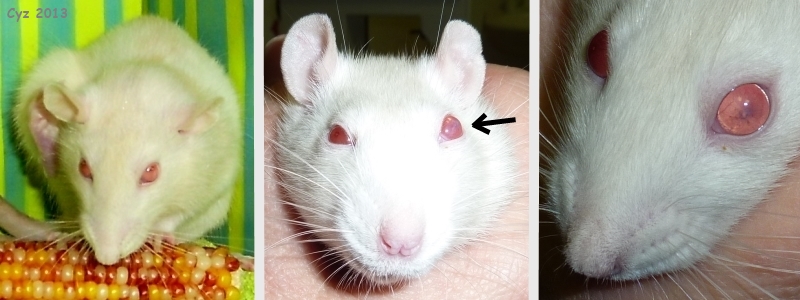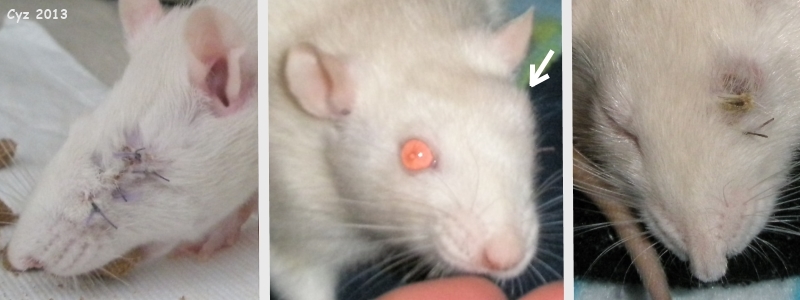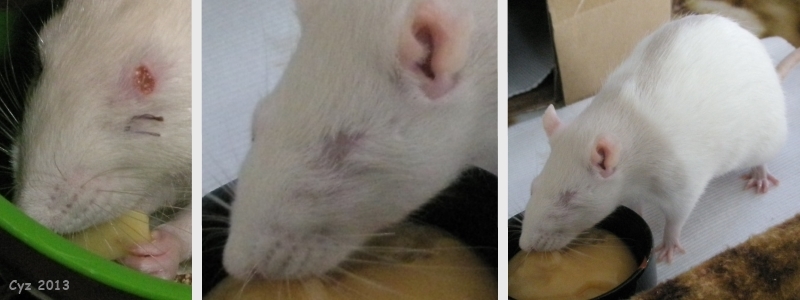Figure 2g: Left eye enucleation with postop abscess in female rat (Yasmine).
Case history and photos
History
Yasmine (intact female rat) was adopted from a rat rescue in March 2010. She was guessed to be about 1 year old at the time. She is fawn hooded with pink eyes.
Clinical Signs
Upon her adoption on 11 March, it is noted that Yasmine’s left eye appears to protrude slightly and is cloudy (milky) around the pupil, either within the cornea or within the globus. The rat rescue confirms the observation and states that something has seemed “abnormal” about the left eye for “a day or so”. In the subsequent weeks (while undergoing treatment) the protrusion appears to lessen slightly, while the cloudiness appears to worsen slightly.
Additionally relevant symptoms:
- no obvious irritation or pain of the left eye (no scratching)
- no obvious sensitivity to light of the left eye (no excessive blinking)
- no porphyrin discharge of the left eye
- occasional accumulation of clear to yellowish liquid in the anterior corner of the left eye (this is noticed upon waking and appears to be the result of a film formation during sleep; the liquid is easily soaked up by gently dabbing with kitchen roll paper, making sure not to touch the cornea)
- left eye appears normally moist
- left eyelid can be closed normally
- head region appears to smell like “salt water” (possible abscess smell?)
- no discharge from either ear
- infrequent sneezing
- eats hard foods without difficulty
- weight loss: 13 March = 330g and 1 April = 265g
Possibly relevant: -Yasmine poos/pees in the closed rat wheel in which she runs, occasionally resulting in her feet being caked in poo, which she grooms (licks) off.
Diagnosis
Yasmine is taken to a veterinarian on 17 March. She confirms that the problem is “internal”. Topical staining of the eye rules out damage to the corneal surface. Possible causes are said to be a blow to the head or a molar infection resulting in spread of infection involving the eye.
No lung problems are noted and treatment for the sneezing is not considered necessary.
(*Note that this veterinary clinic is unable to perform tonometry on rat eyes.)
Treatment
Prior to consulting a vet, CAF eye drops were applied from the day of adoption, twice daily for 7 days. (Note that this is the standard treatment recommended by this veterinary clinic, which is why the initial treatment is started without first consulting the veterinarian.) These eye drops did not appear to help noticeably.
The veterinarian subsequently prescribes Gentapolycort eye drops, which are applied twice daily for 11 days, and thrice daily for 9 days. When necessary, the left eye is cleaned prior to application of the eye drops by gently rinsing it with a luke warm saline solution and/or carefully dabbing kitchen roll paper to the corner of the eye to soak up liquid. Yasmine does not object to the eye drop application, but does groom them off (her cage-mate also does this). The second eye drops also do not appear to help noticeably.
Since Yasmine is losing weight rather rapidly, she is taken back to the veterinarian on 7 April, for an inspection of her molars under anesthesia. No abnormalities are found in her mouth, nor are any abnormalities found within the left eye socket. Nevertheless, while Yasmine is still under anaesthesia, the veterinarian consults with her caretaker and the decision is made to remove the left eye, as the protrusion appears to be causing her significant discomfort (as indicated by the weight loss). The enucleation surgery goes well. Histopathology is not performed on the enucleated eye.
Yasmine is prescribed Carprofen Drops twice daily for 3 days, and Enrofloxoral Drops twice daily for 7 days.
Follow up
By day 7 post-op the incision has healed, and on day 12 the stitches are removed by a veterinary assistant.
*Note that Yasmine’s left whiskers and left & right eyebrow whiskers were trimmed to allow easy access to her left eye during surgery; this does not appear to affect her. Yasmine’s fur (with the exception of a small scar) and whiskers regrow within a month.
Yasmine quickly regains the bodyweight that she had lost, confirming that she was indeed in discomfort prior to the enucleation surgery.
On 5 May (day 29 post-op), a lump forms just above the location of Yasmine’s (previously) left eye. During the subsequent days it rapidly increases in size.
On 9 May, due to unavailability of the veterinarian who performed the surgery, Yasmine is taken to another veterinarian. Her advice is to “wait and see” whether the lump is an abscess or a tumour. She prescribes Doxoral Aqua Drops once daily.
Within 7 days a crust forms on the lump, after which it starts to gradually decrease in size. It becomes clear that the lump is freely moveable with respect to the skull and eye socket. By day 10 the lump has disappeared. The Doxoral Aqua Drops are discontinued on day 13.
Outcome
Yasmine appears completely unaffected by the fact that her left eye is gone. There was no noticeable adjustment period. She appears to locate humans primarily through sound.
Photos
 The photo on the left shows a healthy Yasmine in September 2009. The photos on the right show the protrusion of the left eye (indicated by a black arrow), as well as the cloudiness within the left eye; they were taken on day 9 of the eye drop treatment(s). Note that the tissues surrounding the affected eye do not appear irritated. |
 The first photo was taken on day 6 after the enucleation surgery. Purple stitches were used to close the wound externally. The second photo, taken 32 days after the surgery, shows the abscess formation: the white arrow points to a large lump where the left eye used to be. A scab formed on the lump on day 36 (not shown), after which spontaneous draining took place. The third photo was taken shortly afterwards (day 38). |
 The photo on the left, taken on day 40 post-op, shows continued healing. The photo on the right – and the enlarged version in the middle – were taken on day 45 post-op and show Yasmine completely healed, eating baby food. She quickly gained body weight after the enucleation surgery, suggesting that she had previously been eating less due to pain. |
Case history and photos courtesy of Cyzahhe


